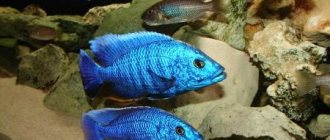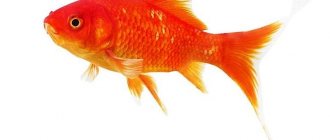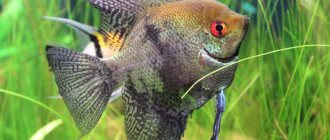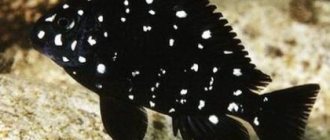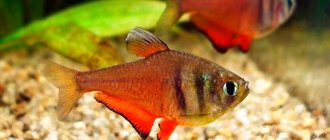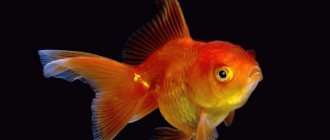Order, family: cichlids.
Comfortable water temperature: 23-24 °C
Ph : doesn't matter
Aggressiveness: 80% are aggressive.
Compatibility: with cichlids.
Description:
The fish's homeland is East Africa. It is found starting from the Yarkon River - near Tel Aviv and further in the Nile River, in the Lake Chad basin; the Niger river system, the Volta, Gambia, Senegal rivers; lakes Alberta, Edward, Kivu and shallow areas of Lake Tanganyika; lakes of Ethiopia, Turkana (Lake Rudolf), in the Suguta River, Lake Baringo.
The fish is known throughout the world and not only to the aquarium community; in some countries, Nile tilapia is a commercial object. This is primarily due to the size of the fish, which can reach a length of 50 cm.
The fish has a tall body and variable bright colors. Has a large mouth with thick lips. During the mating season, the color of the male becomes rich and black, the dorsal fin has a bright red border.
Nile tilapia has pronounced sexual dimorphism. Males are large and their color is brighter than that of females.
There is no need to create any specific conditions for keeping fish. The composition of the water is not particularly important. However, the water temperature in the aquarium should be 23-24°C. The aquarium is equipped with aeration and filtration; the soil can be in the form of small pebbles or coarse gravel. The aquarium is decorated in a tropical style. Lighting is dim, diffused.
Tilapia are unpretentious in feeding. They feed on tubifex, bloodworms, and finely chopped pieces of meat and fish. The diet should contain plant foods.
With a good and varied diet, tilapia become sexually mature at the age of 7-12 months.
Onset of sexual maturity: 5-6 months Weight: 28-350 g Sex ratio for spawning: 2-5 females per male - 7-10 broods Number of successful spawnings/week: 20-30% Eggs per gram of breeder weight: 1-4 pieces Survival of eggs and fry (< 5 g): 70-90% Survival of juveniles (5-30 g): 60-90%
Survival rate of adults (30-680 g): 70-98% Requirements for environmental conditions: Water temperature: optimal 28-32°C, optimal for spawning and embryo development 25-30°C Dissolved oxygen concentration: more than 3.0 mg/ l Carbon dioxide concentration: less than 15 mg/l Salinity: 0-28 ppm pH: 6.0-8.5 Alkalinity: 50-700 mg/l Total (NH3/NH4+): 0.5-1 mg/l
External structure
Tilapia has a tall body, drawn together at the sides, reaching 40 cm in nature, but in aquariums the common tilapia grows up to 20 cm. It is a fish with a large head and mouth, whose jaws are long and strong, and whose lips are full.
The color of tilapia is mostly gray-greenish, acquiring a yellowish tint with age. It intensifies its color when excited. During the spawning period, the body darkens significantly and acquires a black tint, but the throat remains white. The natural type of tilapia has red stripes along the edges of the fins, but today artificial specimens with pink or yellow coloring have also been bred.
The difference between the male appears in the form of multiple milky spots on the caudal fin and larger body sizes. Male tiger tilapia have 5-6 black spots on the sides, and a pink tint on the throat.
The largest aquarium fish. Description with photos and videos
Share:
Turquoise Akara
Turquoise acara (Andinoacara rivulatus) is a large aquarium fish. The length of adult individuals can reach 18-20 cm. Acaras do not have the brightest color. Her body has a basic gray-green coloring with a slight turquoise tint.
Turquoise acara are able to distinguish their owner from other people and even allow themselves to be stroked. They are not shy, sometimes curious. When a person appears, the fish swim up to the glass and watch him. Cancer is best kept in pairs or groups.
Given their size, they need a spacious aquarium (the volume depends on the number of fish in it).
Cichlazoma severum
Cichlasoma severum, or false discus (Cichlasoma severum) are peace-loving fish. They can show aggression towards neighbors only during the spawning period. False discus have a laterally flattened body, the length of which is up to 20 cm.
They can come in a variety of colors. These bright, large fish prefer the lower and middle layers of water. They require the same conditions as most large aquarium fish.
Diamond cichlazoma
Diamond or pearl cichlid (Cichlasoma cyanoguttatum) is another representative of the cichlid family. It changes the basic background color depending on its condition and the state of the environment.
Color can vary from gray-blue to brown. All over the body of these large (up to 23 cm) fish there are small pearlescent spots. During the spawning period, diamond cichlamosas change their color to black and white.
Cichlazoma bee
Cichlazoma bee, or biocelatum (Nandopsis octofasciatum), like many other large fish, has a violent temperament. She can deal with small fish and start quarrels with medium and large relatives.
In addition, plants will also not go unnoticed by these cichlids, which reach a length of 20-25 cm, so it is better to plant hard-leaved plants in pots.
To reduce the aggression of fish, it is recommended to select an aquarium at the rate of 100 liters per 1 fish, and also add food of animal origin to the diet.
Astronotus oscar
Astronotus oscar, or ocellated astronotus, or peacock's eye (Astronotus ocellatus), is a picky, slightly shy fish.
In the natural environment, it can reach a length of 40 cm, but in aquariums, astrotonus, as a rule, does not exceed 25-30 cm.
It is recommended to keep these large fish in groups of six or more individuals, separately from other fish, or in the vicinity of fish of similar size. The volume of the aquarium is determined as 100 liters per 1 individual.
Piranha
Piranhas are one of the largest fish kept in captivity. These exotic fish with sharp teeth look inconspicuous, but the very keeping of piranhas in an aquarium is of particular interest to many lovers of predatory fish. Piranhas have a body length of up to 50 cm.
They are demanding fish. They need to provide not only the necessary space, but also change the water by 30% every week, ensure filtration and aeration of the water, and monitor the saturation of the fish to reduce the risk of cannibalism.
Uaru
Uaru (Uaru amphiacanthoides) are beautiful and large fish with a complex “character”. Huarus grow up to 30 cm, but in aquariums they often do not exceed 18 cm. They need to maintain a dH level of around 10, otherwise the huarus begin to get sick.
Huaru are predators, so their diet must include meat. But, despite being carnivorous, these large fish do not attack other fish in the aquarium (this does not apply to small ones), but simply terrorize and oppress them.
Botia clown
Clown botia (Botia macracanthus) are interesting, active fish. They have an original color, and their body length can reach 30 cm. Of course, in a small aquarium, owners are unlikely to be able to grow such large bots. A notable feature of the behavior of clown loaches is their “habit” of lying on their back or side.
This is often intimidating for beginners, but there is no need to rush to remove the fish from the water. Firstly, clown battles rest this way, and secondly, they have special spikes that can injure a person. It is better to keep clowns in a school, and as neighbors it is worth choosing fish with average activity.
Zebra tilapia
Buttikofer tilapia, or zebra tilapia (Tilapia buttikoferi) are aggressive fish that are recommended to be kept in pairs. With age, the character of these fish becomes even more quarrelsome and explosive. They cannot get along with fish of other species, nor live in crowded conditions.
In addition, they dig the soil, undermining plants, so it is better to fill the aquarium with artificial or floating plants. Buttikofer's tilapia are quite large. Adults can be up to 30 cm long. A pair of such fish requires an aquarium with a volume of at least 200 liters.
Brocade pterygoplicht
Brocade pterygoplichthys (Pterygoplichthys gibbiceps) is a representative of the chain-mail catfish family. They grow slowly and reach their maximum size by 5 years, with an overall average lifespan in an aquarium of up to 15 years. The length of adult brocade pterygoplichts is approximately 50-60 cm. They need a spacious aquarium (at least 200 liters). In addition, these bottom-dwelling giants lead a twilight lifestyle, so they need shelter and snags where they can wait out the day. Share on social networks:
Source: https://loveanimal.ru/blog/samye_bolshie_akvariumnye_rybki_opisanie_s_foto_i_video/2016-05-17-851
Content
The fish are easy to care for, but require space in the aquarium. Tilapia is a territorial creature, so it is best to keep it in a species aquarium with other cichlids. In a community aquarium, a fish may become aggressive towards other fish, defending its shelter.
The optimal volume of an aquarium is 100 liters with a water temperature of 20-35°C, pH7-8.5, hardness 4°-15° with filtration and aeration. Although the composition of the water does not play a special role, since tilapia has endurance and resistance to chlorine impurities. In a small aquarium, males will not be able to create hiding places for their females, which will provoke fights among them.
The fish does not need plants; it is better to lay out driftwood, labyrinths and stones in such a way as to provide shelter for the females. Mixed soil, fine gravel, pebbles and sand. The lighting is dim, the corners are shadowed. A 1/4 fresh water change should be done weekly.
Tilapia is a cute cichlid native to Africa.
Tilapia is a name that summarizes several hundred species of fish that belong to the cichlid family. The latter have chosen warm African and Asian waters. Given where the family is found, Aristotle called tilapia a “distant fish.” The Egyptians considered the fish sacred.
Tilapia are divided into two categories: commercial and aquarium. The difference is mainly in size. The first ones, which are grown for industrial purposes, reach 5 kg and 40 cm; their meat is highly valued by gourmets.
Decorative fish are smaller, but they are also impressive in size - they can grow up to 15-20 cm in length. There are about 70 aquarium varieties. Tilapia differ in color, but silver-green fish are predominantly found. The older the fish, the more the color tends to yellow-green shades.
The fish has the following characteristic features:
- large lipped mouth;
- dark stripes located throughout the body;
- The anal and dorsal fins of the female are smaller than those of the male.
Tilapia are cheerful and active. They live in aquariums for 10-12 years.
Kinds
Despite the existence of dozens of species of aquarium tilapia, the most popular are four:
- zebra tilapia, also known as discoid tilapia; in natural conditions inhabits fresh and slightly brackish water bodies of Liberia; aquarists give it credit for its very beautiful appearance - the fish is indeed very similar to a zebra with fins; disc tilapia is peaceful, but during the pre-spawning period it becomes somewhat aggressive;
- Mozambican tilapia; the habitat is clear from the name - this is a fish that lives in Mozambique; the color is predominantly dark, the lower part of the head is light; during spawning and periods of excitement, Mozambican tilapia becomes almost black; in aquariums, artificially bred fish with pink, yellow and red colors are often found;
- Nile tilapia; came to our country relatively recently; it is characterized by a pink-red color, females are brighter in color; in natural African conditions, fish up to half a meter long live;
- tiger tilapia, or spotted - sometimes called Mary tilapia due to incorrect transcription; like the zebra, it has a magnificent color - the background color is golden, there are 5-6 dark spots-stripes on the body; in a calm state, the “inserts” are spots, but in an excited state the fish becomes more striped.
Maintenance and care
Of course, the main requirement is a large aquarium. In a hundred-liter "small family" tilapia will be a bit cramped. A pair of fish requires a container of 200-300 liters.
- optimal temperature - 20-35°C;
- pH 7-8.5.
Aeration and filtration are required. The composition of the water does not play a special role; tilapia tolerate chlorine impurities well. Giants do not particularly need plants as decoration; they prefer stones and driftwood. Mixed soil is needed: pebbles, fine gravel and sand.
The lighting is preferably dim. A quarter of the water needs to be replaced every week.
Feeding
Tilapias are omnivores. They feed on phytoplankton, bloodworms, daphnia, and tubifex. Do not neglect granulated feed. But the main diet consists of soft plants: spinach, blue-green algae, elodea... Sometimes the fish are not averse to eating meat.
Reproduction
Tilapia is ready to spawn at 10 months of age under good environmental conditions. This fish has various options for storing eggs. Often females lay eggs on smooth stones or leaves without growths. Others spawn in holes specially dug by them or their partner.
But there is an individual feature inherent in this fish - storing caviar in the mouth. First, the female digs a hole at the bottom into which she lays her eggs, after which the tilapia collects them in her mouth for the entire incubation period. After 2 weeks, the fry emerge, and if there is no danger around, they frolic and feed on zooplankton, brine shrimp and cyclops.
The fry will be protected from various diseases, since the mucous membrane of tilapia secretes a special secretion that affects pathogens. By sorting the eggs in its mouth, tilapia separates the healthy from the weak, releasing strong offspring into the world. During incubation, the female abstains from food.
In preparation for spawning, the males begin their games, chasing the female throughout the aquarium and choosing a place to build a nest. There he digs a hole, which can be up to 20 cm in diameter.
Tilapia does not require a separate aquarium for spawning and the water parameters do not need to be changed. The fish form long-term pairs and the parents take care of their offspring together. Adult females are capable of laying 1000 or more eggs.
Peculiar features of tilapia
- Reacts to the owner and becomes attached to him, swims up during feeding and shows his friendly attitude in every possible way;
- loves to dig and burrow into the ground, pull out plants;
- during spawning, females acquire an amazing silvery-brown hue with dark spots on the sides;
- some species are prone to hermaphroditism;
- Nile controls the number of malaria mosquitoes in the area
- Mozambican helps in the fight against filamentous algae
Currently, the fish is widely popular throughout the world due to its ease of breeding and remarkable habits. Animal psychologists and underwater acoustics specialists are seriously studying the conditioned reflexes of this fish, which resemble those of a dog.
